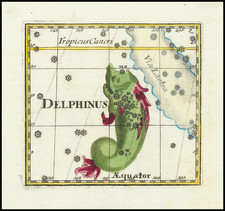A Rarity of the French Revolution -- Capturing the Stars in Revolutionary France -- Embellished With A Poem by Cassini
A striking star chart by Jean-Dominique Cassini’s pupil, the astronomer Jean Perny de Villenueve. It was published in 1791, when Perny had come out in support of the Revolution and just before Cassini would be forced out of his post as Director of the Paris Observatory.
The map is uranographic, showing the constellations visible from Paris; the hemispheric projection was chosen so as to limit distortion of the stars relative to each other. Uranography is the astronomical field of describing and mapping the stars.
The zenith of the Great Bear constellation, or the Big Dipper as it now commonly known, is near the center of the hemisphere, with separate, larger circles for the equator and ecliptic. The London horizon is also marked in a circle slightly smaller than the outside frame. The months are listed in the outer frame circles, indicating which constellations are visible in which months. The brightness of stars is indicated by a key in the lower left.
To make such a map, Jean Perny would have had to combine celestial observation with measurements from sextants and telescopes. These observations, which were likely performed by several savants, could be recorded in a star table, which could then be plotted on a map like this. Such a chart could also be used to trace the paths of other celestial bodies, like comets. If combined with an opaque overlay, the planisphere served as instrument to instruct as to the movements of the stars.
He performed these observations at the Paris Observatory. Founded in 1667, the Observatory was part of the intellectual reforms instigated by J. B. Colbert in the reign of Louis XIV. Gian Domenico Cassini was appointed as the Director of the site, the first of four generations of his family to work there. The institution was subsequently enlarged in 1730, creating the observatory as Perny would have known it.
Perny worked with Jean-Dominique Cassini, also known as Cassini IV. This Cassini is best known for completing his father’s map of France, which was the base for the Atlas National (1791). Cassini IV became Director of the Paris Observatory in 1784. He survived the French Revolution and lived to the age of 97.
Perny was one of several students who lived at the Observatory and earned an annual pension. He had previously served in the military. Perny published several annual astronomical almanacs, including one in 1791. Perny supported the French Revolution early on (indeed, he drunkenly threatened Cassini one night for the latter’s perceived lack of support). When Cassini was pushed out of his post due to Revolutionary politics in September 1793, Perny was appointed as interim director. He also discovered a comet in that year; he called it the Comet of the Republic.
The Cassini name is not absent from this map. A poem attributed to J. D. Cassini is just below the title in a cartouche at the bottom center. This J. D. is actually Cassini I, Cassini IV's great-grandfather. It translates as:
I try to cut lessons short
Science governs and sets the seasons;
Which of the vast universe teaches structure,
And the wandering stars are always sure,
In the eyes of mankind attests the grandeur
The wonders of the world and its creator.
A brief history of uranography to 1800
Uranography, or celestial cartography, is derived from the Greek for “sky” and “to write”; Urania was the Muse of the Heavens in Greek mythology, while Uranus was the god of the starry realm. The planet Uranus is named for him, so called by William Herschel in 1718, when he first observed the planet.
The oldest star charts date from the second millennium BCE. These Babylonian charts were intended to help astrologers predict events. The names of constellations have shifted several times in history, but perhaps the greatest shift came from the Greeks, who named the star shapes after gods and myths. Many of these names survive today, including Orion, Cassiopeia, and Andromeda.
One of the oldest surviving star charts is the Almagest, by Ptolemy, dating to the second century CE. Ptolemy also classified the brightness of stars in six categories, the same number used on this map.
Medieval star charts tended to emphasize the shape and allegory of constellations over their accurate placement in the night sky. The first printed star charts, by Albrecht Durer in 1515, show the stars as seen in each hemisphere. Durer’s southern hemisphere is sparsely populated, but more and more was learned about the southern stars as Europeans increased their expeditions to the East Indies and other austral locales.
Naming and renaming of constellations continued into later periods. Peter Plancius named several constellations after birds at the turn of the sixteenth century, while Nicolas Louis de Lacaille added the Telescope, Microscope, Octant, Pendulum Clock, and Airpump. Many other constellations names came and went, as uranographers called the stars to fit their, or their patrons’, whims. For example, in his 1627 Coelum Stellatum Christianum, Johann Schiller renamed practically all the constellations to reflect his Roman Catholic faith.
The first western star chart plotted using more modern methods and style was Johann Bayer’s Uranometria (1603), which was based on Tycho Brahe’s and Johannes Kepler’s Tabulae Rudolphinae. Other important star charts of this period include Andreas Cellarius’ Harmonia Macrocosmica (1660) and Johannes Hevelius’ Firmamentum Sobiescanum sive Uranometria (1687). These were all based primarily on naked-eye observations. In 1729, John Flamsteed published Atlas Coelestis, which used telescopic observations conducted at the Royal Observatory at Greenwich.
Rarity
The map appears to be quite rare. OCLC lists only the example in the British Library.









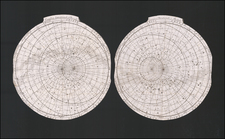
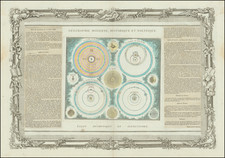
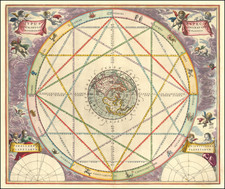
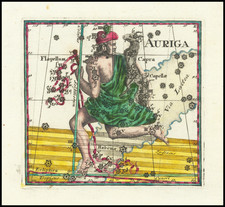
![[Ursa Major]](https://storage.googleapis.com/raremaps/img/small/83173.jpg)
